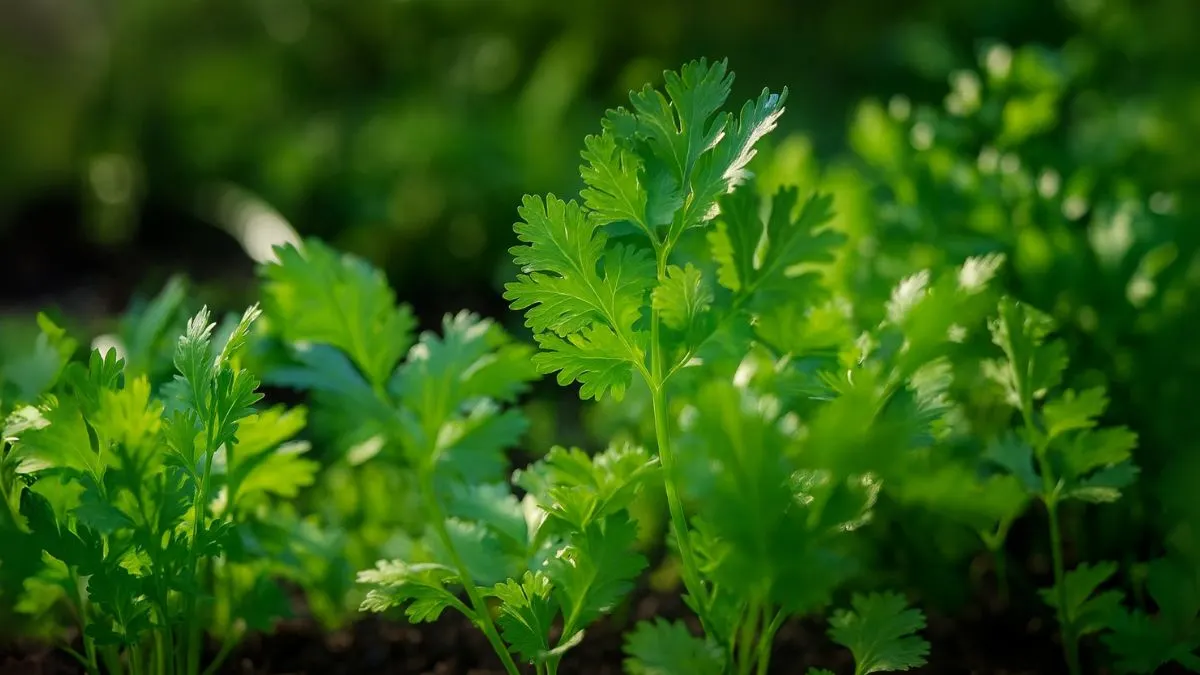Fresh herbs can transform any dish, and coriander (also known as cilantro) tops the list of essentials. Its refreshing aroma and citrusy flavor make it a must-have for salads, curries, and garnishes. The good news? How to grow coriander at home for fresh herbs is simpler than you think.
Whether you have a backyard garden, a balcony, or just a sunny windowsill, coriander thrives almost anywhere. Let’s explore step by step how you can grow it successfully.
Choosing the Right Spot

Coriander loves light but not scorching heat. Ideally, coriander grows best in a sunny spot with which receives four-five hours of light. Too much hot afternoon sun may cause it to bolt early, so a partial shade in hotter regions works better.
💡 Personal Tip: When I grew coriander on my kitchen balcony in summer, I noticed that plants under morning sunlight stayed greener and lasted longer compared to those under direct afternoon rays.
Preparing the Soil
For best growth, you can grow coriander in full sun and well-drained soil with a pH of 6.2 to 6.8. Coriander does not like waterlogged roots, so ensure good drainage by adding sand or compost. Rich, organic matter will encourage healthier leaves and stronger roots.
Before sowing, make shallow drills or furrows of about 1/2 inch depth to place the seeds. Keep the rows about 6–8 inches apart to give each plant breathing room.
Also Read: How to Grow Raspberries Bushes in Pots and Enjoy Endless Harvests
Sowing the Seeds
Now comes the most important step—planting. Always sow split or whole seeds about 1/4 to 1/2 inch deep in well-draining soil, spacing them 6-8 inches apart, and keep the soil consistently moist but not waterlogged.
You can simply sow seeds outdoors, in the ground or in containers. If growing indoors, choose a wide pot that’s at least 8 inches deep. This allows enough space for roots to grow.
💡 Tip: Crushing seeds slightly before planting speeds up germination.
Caring for Cilantro Plants
Once germination begins, you’ll see delicate leaves appear in 7–10 days. At this stage, consistent care is key.
- Water lightly but regularly to keep the soil moist.
- Mulch around the base to retain moisture and keep weeds away.
- Thin seedlings if they’re too crowded, giving each plant enough space to flourish.
Remember, cilantro plants are fast growers but have short lifespans, so succession planting every 2–3 weeks ensures a continuous harvest.
Letting Plants Go to Seed
Here’s where coriander surprises many gardeners. Instead of pulling them out once they flower, try to let your cilantro plants go to seed.
The seeds are nothing but coriander spice! You can collect them for cooking or replant them for the next season. Plus, pollinators love cilantro flowers, making your garden more lively and productive.
Also Read: Spice Up Your Garden with Cinnamon
Growing Coriander in Containers
If space is limited, coriander is still a perfect choice. Wide, shallow containers are ideal. Use fresh potting mix and sow directly since transplanting coriander often causes root disturbance.
Keep the container in a bright spot with good airflow. Indoors, a south-facing window works beautifully. Outdoors, avoid windy areas as delicate stems may topple.
Quick Care Table for Home Gardeners
Growing Step |
Requirement |
Soil Prep |
Well-drained soil, pH 6.2 to 6.8 |
Seed Sowing |
Sow split or whole seeds about 1/4 to 1/2 inch deep, spaced 6-8 inches apart |
Light Needs |
Coriander grows best in a sunny spot with four-five hours of light |
Planting Method |
Simply sow seeds outdoors, in the ground or in containers |
Harvest/Next Cycle |
Let your cilantro plants go to seed for coriander spice & replanting |
Harvesting Fresh Herbs
Coriander leaves can be harvested once they are about 4–6 inches tall. Always pick outer leaves first, letting the inner ones continue growing. Regular harvesting actually promotes more growth.
If you prefer seeds, wait until the plant flowers and dries. The brown seeds can then be collected, stored, or replanted.
Also Read: Cosmos That Thrive in Poor Soil and Full Sun
Whether you simply sow seeds outdoors, in the ground or in containers, or allow cilantro plants to bloom and let your cilantro plants go to seed, you’ll always have an endless supply of coriander leaves and seeds.
So why wait? Grab some seeds today and transform your meals with the magic of homegrown coriander.






